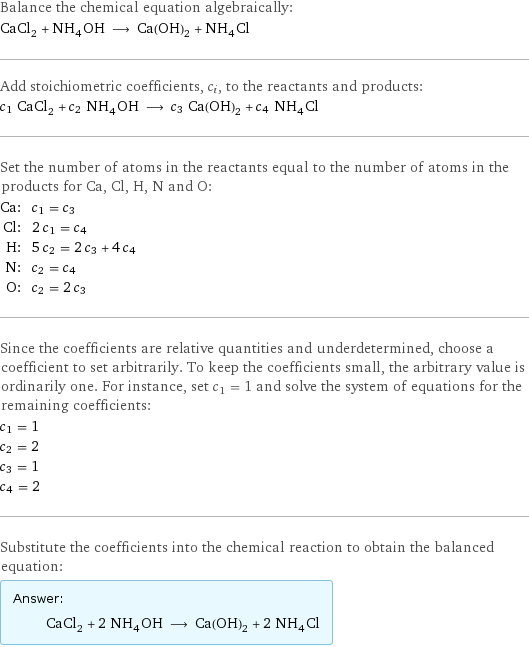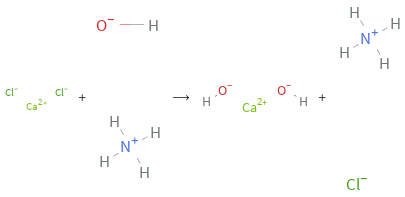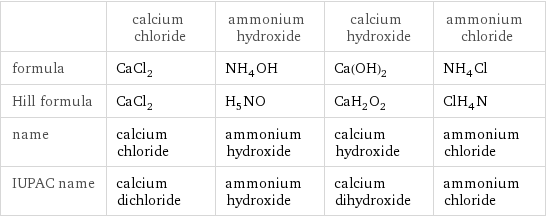Input interpretation

CaCl_2 calcium chloride + NH_4OH ammonium hydroxide ⟶ Ca(OH)_2 calcium hydroxide + NH_4Cl ammonium chloride
Balanced equation

Balance the chemical equation algebraically: CaCl_2 + NH_4OH ⟶ Ca(OH)_2 + NH_4Cl Add stoichiometric coefficients, c_i, to the reactants and products: c_1 CaCl_2 + c_2 NH_4OH ⟶ c_3 Ca(OH)_2 + c_4 NH_4Cl Set the number of atoms in the reactants equal to the number of atoms in the products for Ca, Cl, H, N and O: Ca: | c_1 = c_3 Cl: | 2 c_1 = c_4 H: | 5 c_2 = 2 c_3 + 4 c_4 N: | c_2 = c_4 O: | c_2 = 2 c_3 Since the coefficients are relative quantities and underdetermined, choose a coefficient to set arbitrarily. To keep the coefficients small, the arbitrary value is ordinarily one. For instance, set c_1 = 1 and solve the system of equations for the remaining coefficients: c_1 = 1 c_2 = 2 c_3 = 1 c_4 = 2 Substitute the coefficients into the chemical reaction to obtain the balanced equation: Answer: | | CaCl_2 + 2 NH_4OH ⟶ Ca(OH)_2 + 2 NH_4Cl
Structures

+ ⟶ +
Names

calcium chloride + ammonium hydroxide ⟶ calcium hydroxide + ammonium chloride
Equilibrium constant
![Construct the equilibrium constant, K, expression for: CaCl_2 + NH_4OH ⟶ Ca(OH)_2 + NH_4Cl Plan: • Balance the chemical equation. • Determine the stoichiometric numbers. • Assemble the activity expression for each chemical species. • Use the activity expressions to build the equilibrium constant expression. Write the balanced chemical equation: CaCl_2 + 2 NH_4OH ⟶ Ca(OH)_2 + 2 NH_4Cl Assign stoichiometric numbers, ν_i, using the stoichiometric coefficients, c_i, from the balanced chemical equation in the following manner: ν_i = -c_i for reactants and ν_i = c_i for products: chemical species | c_i | ν_i CaCl_2 | 1 | -1 NH_4OH | 2 | -2 Ca(OH)_2 | 1 | 1 NH_4Cl | 2 | 2 Assemble the activity expressions accounting for the state of matter and ν_i: chemical species | c_i | ν_i | activity expression CaCl_2 | 1 | -1 | ([CaCl2])^(-1) NH_4OH | 2 | -2 | ([NH4OH])^(-2) Ca(OH)_2 | 1 | 1 | [Ca(OH)2] NH_4Cl | 2 | 2 | ([NH4Cl])^2 The equilibrium constant symbol in the concentration basis is: K_c Mulitply the activity expressions to arrive at the K_c expression: Answer: | | K_c = ([CaCl2])^(-1) ([NH4OH])^(-2) [Ca(OH)2] ([NH4Cl])^2 = ([Ca(OH)2] ([NH4Cl])^2)/([CaCl2] ([NH4OH])^2)](../image_source/37d4a54ae13ed8746243ab701c92e9d3.png)
Construct the equilibrium constant, K, expression for: CaCl_2 + NH_4OH ⟶ Ca(OH)_2 + NH_4Cl Plan: • Balance the chemical equation. • Determine the stoichiometric numbers. • Assemble the activity expression for each chemical species. • Use the activity expressions to build the equilibrium constant expression. Write the balanced chemical equation: CaCl_2 + 2 NH_4OH ⟶ Ca(OH)_2 + 2 NH_4Cl Assign stoichiometric numbers, ν_i, using the stoichiometric coefficients, c_i, from the balanced chemical equation in the following manner: ν_i = -c_i for reactants and ν_i = c_i for products: chemical species | c_i | ν_i CaCl_2 | 1 | -1 NH_4OH | 2 | -2 Ca(OH)_2 | 1 | 1 NH_4Cl | 2 | 2 Assemble the activity expressions accounting for the state of matter and ν_i: chemical species | c_i | ν_i | activity expression CaCl_2 | 1 | -1 | ([CaCl2])^(-1) NH_4OH | 2 | -2 | ([NH4OH])^(-2) Ca(OH)_2 | 1 | 1 | [Ca(OH)2] NH_4Cl | 2 | 2 | ([NH4Cl])^2 The equilibrium constant symbol in the concentration basis is: K_c Mulitply the activity expressions to arrive at the K_c expression: Answer: | | K_c = ([CaCl2])^(-1) ([NH4OH])^(-2) [Ca(OH)2] ([NH4Cl])^2 = ([Ca(OH)2] ([NH4Cl])^2)/([CaCl2] ([NH4OH])^2)
Rate of reaction
![Construct the rate of reaction expression for: CaCl_2 + NH_4OH ⟶ Ca(OH)_2 + NH_4Cl Plan: • Balance the chemical equation. • Determine the stoichiometric numbers. • Assemble the rate term for each chemical species. • Write the rate of reaction expression. Write the balanced chemical equation: CaCl_2 + 2 NH_4OH ⟶ Ca(OH)_2 + 2 NH_4Cl Assign stoichiometric numbers, ν_i, using the stoichiometric coefficients, c_i, from the balanced chemical equation in the following manner: ν_i = -c_i for reactants and ν_i = c_i for products: chemical species | c_i | ν_i CaCl_2 | 1 | -1 NH_4OH | 2 | -2 Ca(OH)_2 | 1 | 1 NH_4Cl | 2 | 2 The rate term for each chemical species, B_i, is 1/ν_i(Δ[B_i])/(Δt) where [B_i] is the amount concentration and t is time: chemical species | c_i | ν_i | rate term CaCl_2 | 1 | -1 | -(Δ[CaCl2])/(Δt) NH_4OH | 2 | -2 | -1/2 (Δ[NH4OH])/(Δt) Ca(OH)_2 | 1 | 1 | (Δ[Ca(OH)2])/(Δt) NH_4Cl | 2 | 2 | 1/2 (Δ[NH4Cl])/(Δt) (for infinitesimal rate of change, replace Δ with d) Set the rate terms equal to each other to arrive at the rate expression: Answer: | | rate = -(Δ[CaCl2])/(Δt) = -1/2 (Δ[NH4OH])/(Δt) = (Δ[Ca(OH)2])/(Δt) = 1/2 (Δ[NH4Cl])/(Δt) (assuming constant volume and no accumulation of intermediates or side products)](../image_source/d2105c9c6a2de531fb7152fa43fd7e4f.png)
Construct the rate of reaction expression for: CaCl_2 + NH_4OH ⟶ Ca(OH)_2 + NH_4Cl Plan: • Balance the chemical equation. • Determine the stoichiometric numbers. • Assemble the rate term for each chemical species. • Write the rate of reaction expression. Write the balanced chemical equation: CaCl_2 + 2 NH_4OH ⟶ Ca(OH)_2 + 2 NH_4Cl Assign stoichiometric numbers, ν_i, using the stoichiometric coefficients, c_i, from the balanced chemical equation in the following manner: ν_i = -c_i for reactants and ν_i = c_i for products: chemical species | c_i | ν_i CaCl_2 | 1 | -1 NH_4OH | 2 | -2 Ca(OH)_2 | 1 | 1 NH_4Cl | 2 | 2 The rate term for each chemical species, B_i, is 1/ν_i(Δ[B_i])/(Δt) where [B_i] is the amount concentration and t is time: chemical species | c_i | ν_i | rate term CaCl_2 | 1 | -1 | -(Δ[CaCl2])/(Δt) NH_4OH | 2 | -2 | -1/2 (Δ[NH4OH])/(Δt) Ca(OH)_2 | 1 | 1 | (Δ[Ca(OH)2])/(Δt) NH_4Cl | 2 | 2 | 1/2 (Δ[NH4Cl])/(Δt) (for infinitesimal rate of change, replace Δ with d) Set the rate terms equal to each other to arrive at the rate expression: Answer: | | rate = -(Δ[CaCl2])/(Δt) = -1/2 (Δ[NH4OH])/(Δt) = (Δ[Ca(OH)2])/(Δt) = 1/2 (Δ[NH4Cl])/(Δt) (assuming constant volume and no accumulation of intermediates or side products)
Chemical names and formulas

| calcium chloride | ammonium hydroxide | calcium hydroxide | ammonium chloride formula | CaCl_2 | NH_4OH | Ca(OH)_2 | NH_4Cl Hill formula | CaCl_2 | H_5NO | CaH_2O_2 | ClH_4N name | calcium chloride | ammonium hydroxide | calcium hydroxide | ammonium chloride IUPAC name | calcium dichloride | ammonium hydroxide | calcium dihydroxide | ammonium chloride
Substance properties

| calcium chloride | ammonium hydroxide | calcium hydroxide | ammonium chloride molar mass | 111 g/mol | 35.046 g/mol | 74.092 g/mol | 53.49 g/mol phase | solid (at STP) | aqueous (at STP) | solid (at STP) | solid (at STP) melting point | 772 °C | -57.5 °C | 550 °C | 340 °C boiling point | | 36 °C | | density | 2.15 g/cm^3 | 0.9 g/cm^3 | 2.24 g/cm^3 | 1.5256 g/cm^3 solubility in water | soluble | very soluble | slightly soluble | soluble odor | | | odorless |
Units
